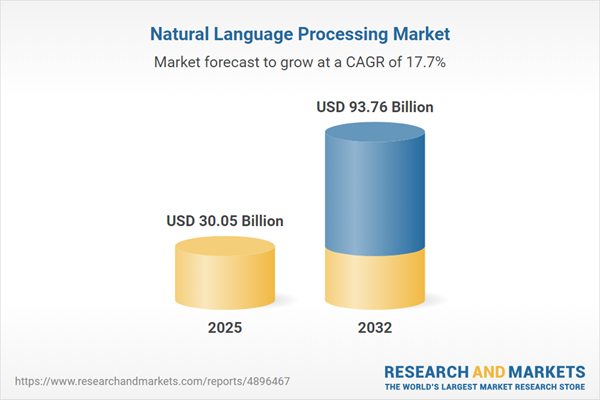Speak directly to the analyst to clarify any post sales queries you may have.
Natural Language Processing (NLP) is rapidly reshaping the way enterprises extract value from text and speech, enabling strategic decisions and innovation that grow market share while managing new technology risks.
Market Snapshot: Global Natural Language Processing Market
The global Natural Language Processing market grew from USD 25.49 billion in 2024 to USD 30.05 billion in 2025. With a CAGR of 17.67%, the market is anticipated to reach USD 93.76 billion by 2032. This expansion is driven by the surge in unstructured data, advances in artificial intelligence, and a broadening set of use cases across multiple regions and industry verticals.
Scope & Segmentation
This comprehensive report provides detailed segmentation to support enterprise planning and market benchmarking:
- Component: Services (Managed Services, Professional Services), Solutions
- Deployment Type: Cloud, On Premises
- Organization Size: Large Enterprises, Small & Medium Enterprises
- Application: Conversational AI (Chatbots, Virtual Assistants), Machine Translation, Sentiment Analysis, Speech Recognition, Text Analytics
- End-User: Banking Finance & Insurance, Healthcare, IT & Telecom, Manufacturing, Retail & eCommerce
- Geography: Americas (North America, Latin America), Europe, Middle East & Africa, Asia-Pacific
- Key Players: Alphabet Inc., Microsoft Corporation, Amazon.com, Inc., International Business Machines Corporation, Oracle Corporation, SAP SE, Baidu, Inc., Tencent Holdings Limited, NVIDIA Corporation, Adobe Inc.
Analytical coverage further explores trends in emerging deployment models, regulatory-driven demand shifts, and the role of advanced technologies such as hybrid architectures and AI accelerators.
Key Takeaways: Strategic Directions for Enterprise Leaders
- NLP is now a strategic business driver, fueling innovation and empowering companies to extract actionable insights from vast volumes of unstructured data.
- Hybrid architectures blending symbolic reasoning and deep learning are advancing the accuracy and reliability of NLP solutions, especially for regulated or domain-specific applications.
- Organizations are prioritizing fairness, data privacy, and ethical AI, embedding these considerations into development pipelines to protect reputation and build trust.
- Adoption patterns vary by size; large enterprises often create proprietary pipelines, while startups and SMEs leverage modular, standardized solutions for agility and lower upfront cost.
- Regional differences underscore the influence of cloud infrastructure maturity, data privacy regulations, and multilingual requirements—each shaping technology procurement and go-to-market strategies.
- Collaboration between established technology vendors and niche AI startups is accelerating time-to-market and broadening the capabilities of NLP deployments across sectors.
Tariff Impact: Navigating the 2025 U.S. Tariff Landscape
The proposed United States tariffs in 2025 create new challenges for NLP supply chains. Organizations are adjusting sourcing strategies, with some shifting to regional manufacturing partnerships to reduce exposure to hardware import duties. Cloud service providers are responding by securing multi-year procurement contracts, which directly affect pricing and service commitments. For enterprises, balancing global scalability with local resilience is increasingly critical when managing procurement and deployment strategies in a protectionist environment.
Methodology & Data Sources
This analysis relies on a robust, multi-phase methodology. It integrates extensive reviews of public filings and industry literature, primary interviews with executives and domain experts, and data triangulation using vendor performance metrics, deployment case studies, and regional investment patterns. The research process ensures balanced, evidence-based conclusions that are relevant to diverse stakeholders.
Why This Report Matters to Senior Decision-Makers
- Provides actionable insights to guide long-term technology investment, vendor selection, and compliance strategies in a fast-evolving NLP environment.
- Enables benchmarking against leading competitors and highlights critical success factors for operational resilience, scalability, and regulatory conformance.
- Delivers a clear synthesis of strategic risks and opportunities, supporting executive buy-in and informed decision-making for language-driven transformation.
Conclusion
NLP technologies are at the heart of business transformation, enabling tailored, secure, and scalable solutions for global enterprises. Informed strategy, robust governance, and close collaboration with technology partners will define future success in this dynamic market.
Additional Product Information:
- Purchase of this report includes 1 year online access with quarterly updates.
- This report can be updated on request. Please contact our Customer Experience team using the Ask a Question widget on our website.
Table of Contents
3. Executive Summary
4. Market Overview
7. Cumulative Impact of Artificial Intelligence 2025
Companies Mentioned
The companies profiled in this Natural Language Processing market report include:- Alphabet Inc.
- Microsoft Corporation
- Amazon.com, Inc.
- International Business Machines Corporation
- Oracle Corporation
- SAP SE
- Baidu, Inc.
- Tencent Holdings Limited
- NVIDIA Corporation
- Adobe Inc.
Table Information
| Report Attribute | Details |
|---|---|
| No. of Pages | 186 |
| Published | November 2025 |
| Forecast Period | 2025 - 2032 |
| Estimated Market Value ( USD | $ 30.05 Billion |
| Forecasted Market Value ( USD | $ 93.76 Billion |
| Compound Annual Growth Rate | 17.6% |
| Regions Covered | Global |
| No. of Companies Mentioned | 11 |









